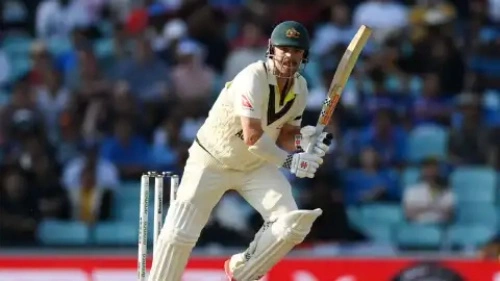India prevailed in the toss but not much else during three challenging games at The Oval. Australia 327 for 3 against India (Head 146*, Smith 95*).

Haddin analyses Head’s risky game.
Head’s Maiden Century and Smith’s Stellar Performance Propel Australia in WTC Final
By the conclusion of the first day at The Oval, Australia was in the driver’s seat for the WTC final, thanks to Travis Head and Steven Smith’s feast on India’s erratic attack in difficult batting conditions. As they led Australia from 76 for 3 to 327 for 3 at stumps, Travis Head hit his maiden century outside of Australia, and Steven Smith fell five short of his 30th overall. Head scored an undefeated 146 from 156 balls with 22 fours and a six, turning his century—the first in a WTC final—into a significant score.

Choosing a fourth fast bowler over R Ashwin, a tactic that helped India defeat England in 2021, was still the primary talking point. The 6mm of grass cover on the field and the morning’s cloud cover may have had an impact, but they didn’t exhibit the kind of control one would anticipate from the third and fourth quicks in a four-person pace assault. Umesh Yadav and Shardul Thakur combined to bowl 32 overs for 129 runs and just one wicket.
After India put Australia in, Mohammed Shami and Mohammed Siraj were effective with the new ball, as usual. Usman Khawaja was dismissed for a duck during the first hour’s 12 overs, and the 21 false alarms that were induced hinted that there could have been one or two more on the way.
However, following that initial phase of play, the alternate bowlers Umesh and Thakur supplied several reasonably simple runs. In his second over, Umesh, who had just sent David Warner a half-volley second ball into the attack, was hit for four square or behind square boundaries.
Warner would have believed it was his due after putting up with so much hardship for the first hour, but India was fortunate to have Thakur catch him down the leg side off a short ball just before lunch.
After lunch, India turned to Siraj and Shami, two bowlers likely to yield a wicket. Shami’s opening delivery was peach seaming to remove Marnus Labuschagne’s off stump. India still had a chance if they could execute well for an extended period.
The Head had other intentions after losing his No. 5 spot in India under a horses-four-courses policy. Shami had a left-handed batter in his sights, he had just begun a new stint, and the ball was still seaming. Shami initially defeated Head, but Travis Head soon made India pay for it.
Travis Head’s Strategy
Travis Head faced a fifth ball, which was just somewhat wide and shot, and he smashed it away for four. His offside attacking strategy left India struggling for inspiration. They shifted a slip to put a sweeper back on the offside, but Head was quick to capitalize on anything too straight. Siraj agreed to two of these restrictions.
Smith found it challenging to get used to the uneven bounce and the sideways movement in a small byplay at the opposite end. He answered differently than Head did. Head didn’t mind attacking, but he persisted in fighting it out. Although Travis Head appeared to do better than Steven Smith on the surface, his control percentage was only 69 versus Smith’s 90. Again, they are their functions. Smith erects, and Head launches a defense.
Thakur went looking too much, and things grew simpler for Smith. Thakur is a driven bowler who more frequently bowls full and straight than the competition. It works when you are bowling under the strain of three elite quicks. He went full a few times too frequently while acting practically as the third seamer. Smith made money, leading to a 16-run over.
The fact that India chose Ravindra Jadeja over Umesh in the middle session when the ball was still moving a little for the quicks told a lot about their alternatives. Thakur attempted the leg assault that had been successful for India in Australia for a while, but Steven Smith was ready and willing to wait it out.

On the first day of the final, South London provided the ideal weather for cricket
Australia entered the break at 170 for 3, with Head on 60 off 75 and Smith on 33 off 102. Then, Umesh and Jadeja, India’s least probable bowlers to claim a wicket, started the final session. That was a complete description of the situation India was in.
Almost immediately after Shami returned, India started challenging Head with the short stuff—probably too late in the piece. Head attacked it with vigour. From a long way off, he bottom-edged two hooks before ramping the ball. The runs kept coming even though he was uncomfortable facing the short ball. Smith started receiving leaks from Umesh at the other end.
The two-and-a-half-hour final session seemed even longer for India since they needed to catch up to the above rate. In the session’s opening 18 balls, Head scored 32 points. Then Siraj and Shami placed a beautiful deep third to block the ramp, causing guys to catch on the hook and continue bending down. Siraj continued to have inconsistent bounce from Shami’s seven-over period; Head cruised into the 90s while appearing unsure but riding his luck. He received two blows to the Head yet continued to hook.
By the time Head reached his hundred, India had been forced to alter their bowling attack, and batting had become more straightforward. Twenty minutes before the end of the play, India received the new ball, which led to more spaces and misses by Head and three more boundaries for him. Smith’s menacing cover drive for four off the last ball signaled the end of the day. Read more cricket news here at Indibet India, the best cricket site in India.

